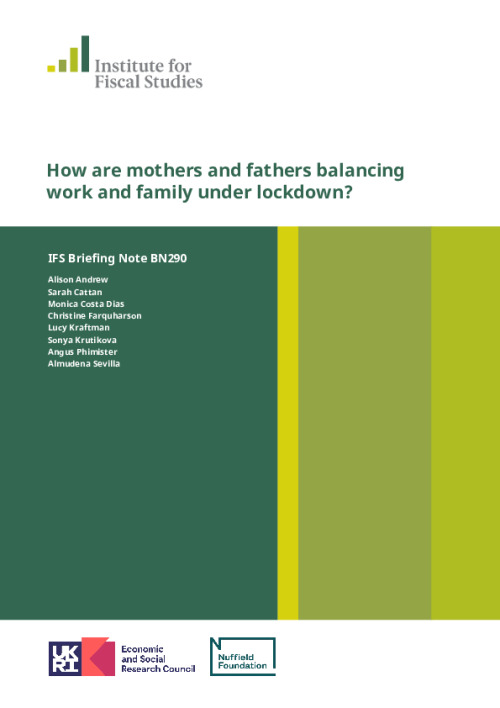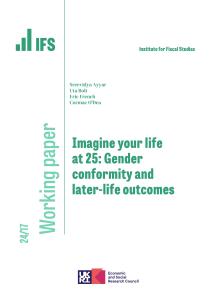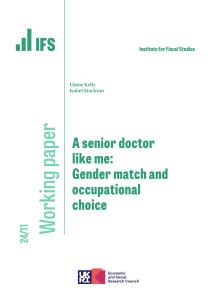The COVID-19 crisis has caused drastic changes to most parents’ work lives and other responsibilities. Millions of adults have lost or are forecast to lose their jobs permanently; many more have stopped work temporarily. Others are newly working from home, while many key workers are experiencing additional pressures and risks in their work. For most parents, school and childcare closures have meant that children are at home, and requiring care, for at least an extra six hours a day.
Although an economic downturn may be inevitable, the effects of COVID-19 and the public health response on the economy as a whole and on specific groups are likely to look very different from those of the economic crises that we are used to. The complete shutdown of certain sectors and the huge increase in households’ care responsibilities are both completely new. And the impacts of these sectoral shutdowns and increases in family responsibilities are likely to look very different for mothers and fathers.
Prior to the crisis hitting, the shut-down sectors disproportionately employed women.[1] And prior to the crisis, mothers typically performed a larger share of childcare and housework than fathers did. This means that, if households continue to divide up domestic responsibilities as they did before, mothers will take on a greater share of the new responsibilities at home and will see a bigger absolute increase in the time they spend on childcare and housework. On the other hand, such a substantial shock to families’ typical arrangements could reshape how families divide paid work and unpaid household responsibilities, with many fathers now at home all day with more exposure to the scale and scope of housework and childcare.
The way that couples divide paid work and household responsibilities during this crisis could have an effect that lasts long after the lockdown is lifted. If, on average, mothers are more likely to step back from paid work during this crisis (either voluntarily or through temporary or permanent job loss) and are more likely to pick up more of the domestic responsibilities, they could face a long-run hit to their earnings prospects. This risks reversing some of the progress that has been made on closing the gender wage gap.
On the other hand, previous evidence suggests that fathers who pick up more household responsibilities (such as childcare) for a limited period of time may do a greater share of them in the longer term.[2] The work culture that relies on the ability of men to do paid work being unaffected by fatherhood may change quickly over this period too, as employers and co-workers may adapt to male employees requiring more flexibility to balance paid work with childcare.
In this report, we examine new data collected since the end of April to investigate how this crisis has affected mothers and fathers in two-parent opposite-gender families. Our survey allows up-to-date insights into the labour market shocks that parents have faced and how parents are balancing their responsibilities under lockdown. In this piece, we focus on how parents divide their time between childcare, housework and paid work, how these arrangements are changing with the lockdown, and the extent to which they vary between men and women.[3]
Key findings:
All points relate to mothers and fathers in households with two opposite-gender parents. Hours of time refer to the number of hour-long slots in which individuals reported doing a given activity on a weekday.
- The pressure on parents’ time is immense. On average, parents are doing childcare during 9 hours of the day, and housework during 3. Among all parents, paid work now takes up an average of just 3 hours, partly driven by the large losses in employment. By contrast, comparable figures from 2014/15 suggest that, on a regular school day, parents did 5½ hours of childcare and 6½ hours of paid work. Furthermore, parents are now often doing at least two activities at the same time.
- Mothers are more likely to have quit or lost their job, or to have been furloughed, since the start of the lockdown. Of parents who were in paid work prior to the lockdown, mothers are one-and-a-half times more likely than fathers to have either lost their job or quit since the lockdown began. They are also more likely to have been furloughed. In all, mothers who were in paid work in February are 9 percentage points less likely to be currently working for pay (either remotely or on-site) than fathers.
- Compared with fathers, mothers are spending less time on paid work but more time on household responsibilities. The time they spend on paid work is also more likely to be interrupted with household responsibilities. Mothers are doing paid work during 2 fewer hours of the day than fathers, but they do childcare and housework during 2 more hours each. Mothers combine paid work with other activities (almost always childcare) in 47% of their work hours, compared with 30% of fathers’ work hours.
- The differences in work patterns between mothers and fathers have grown since before the crisis. In 2014/15, mothers were in paid work at 80% of the rate of fathers; now this is 70% of the fathers’ rate. Mothers in paid work used to work an average of 73% of the hours that fathers worked; this has fallen to 68%. Mothers and fathers used to be interrupted during the same proportion of their work hours; now mothers are interrupted over 50% more often.
- Overall, in 2014/15, the average mother (including those who did not work for pay) was doing nearly 60% of the number of uninterrupted work hours that the average father did; now she is doing only 35%. Since difficult labour market conditions are likely to persist for some time, reductions in paid work now may also persist even after the immediate health crisis is diminished. Workers who have lost their jobs permanently may struggle to find new ones, workers who have reduced their hours may struggle to increase them again, and workers whose productivity has suffered due to interruptions may be penalised in pay and promotion decisions. The disproportionate decrease in mothers’ paid work now suggests any long-lasting effects will be particularly severe for them.
- Families respond differently to a partner stopping paid work depending on whether it is the mother or the father who stops. Mothers who have stopped working for pay during lockdown while their partner continues do twice as much childcare and housework as their partner. In the reverse situation, in families where the father has stopped working, the parents share childcare and housework equally, while the mother also does 5 hours of paid work a day.
- The gaps between mothers’ and fathers’ time use are not straightforwardly explained by mothers’ lower employment rates or lower earnings. Gender gaps in time use remain even when comparing mothers working for pay with fathers working for pay and when comparing mothers and fathers not currently in paid work. Likewise, even in families where mothers were the higher earner before the crisis and both partners are still working, mothers still do more childcare and the same amount of housework as their partner.
- Despite doing less childcare than mothers, during lockdown fathers have nearly doubled the time they spend on childcare. On average, fathers are now doing some childcare during 8 hours of the day, compared with 4 hours in 2014/15. This increase is especially large for the 15% of fathers in previously dual-earner households who have lost their job while their partner continues to do paid work. This large increase in fathers’ involvement in childcare might have long-lasting impacts on how couples share childcare responsibilities.
[1] R. Joyce and X. Xu, ‘Sector shutdowns during the coronavirus crisis: which workers are most exposed?’, IFS Briefing Note BN278, 2020, https://www.ifs.org.uk/publications/14791.
[2] See A. Patnaik, ‘Reserving time for Daddy: the consequences of fathers’ quotas’, Journal of Labor Economics, 2019, 37, 1009–59, https://doi.org/10.1086/703115, M. Tamm, ‘Fathers’ parental leave-taking, childcare involvement and labor market participation’, Labour Economics, 2019, 59, 184–97, https://doi.org/10.1016/j.labeco.2019.04.007 and L. Farré and L. González, ‘Does paternity leave reduce fertility?’, Journal of Public Economics, 2019, 172, 52–66, https://doi.org/10.1016/j.jpubeco.2018.12.002.
[3] Single parents face different challenges around how to meet, often on their own, the increased childcare and housework responsibilities the crisis has created. Studying single parents raises specific issues that we do not address in this report.















